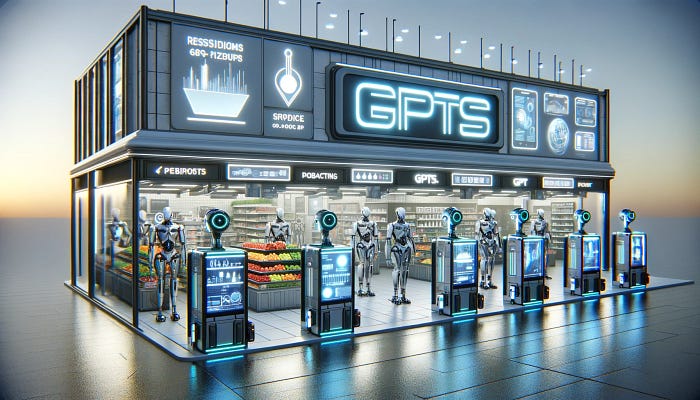Artificial intelligence is reshaping the way we work, with large language models and generative AI disrupting and enhancing traditional workflows and processes. ChatGPT, a revolutionary AI chatbot that can understand natural language prompts and generate human-like responses—stands out as a leader in this space. In a recent update, ChatGPT added the ability for anyone to create customized AI models, known as GPTs, without any coding or technical skills. This represents the next step forward in the specialization of GPTs, enabling more tailored and efficient use of language models to meet specific needs.
Hire the best developers in Latin America. Get a free quote today!
Contact Us Today!In this tutorial, you’ll learn everything you need to know about what custom GPTs are and the benefits they provide over standard models. This article will also walk you through the process of building your own through the ChatGPT UI, and explore some real-world applications so you can unleash your inner AI.
The process is quick and easy. Sounds Good? Let’s jump in!
What are GPTs
GPTs are custom versions of ChatGPT that users can tailor for specific tasks or topics by combining instructions, knowledge, and capabilities. GPT (Generative Pre-trained Transformer) models are originally based on the GPT-3 family of large transformer-based language models which are pre-trained on a large text corpus. A transformer in this context is a deep learning model architecture that is used primarily in the field of natural language processing (NLP).
The pre-training process involves exposing the model to a wide range of linguistic contexts, allowing it to learn the statistical relationships between words and understand the nuances of human language. After pre-training, the model can then be fine-tuned on specific tasks to make it more specialized and accurate for particular applications.
Why Create Your Own GPT?
The ChatGPT model is designed to be a generalist conversationalist on nearly any topic. The idea behind the new custom GPTs is to help subscribers move beyond the standard, general-purpose ChatGPT model by devising more specialized models for more specific areas and tasks.
The technology essentially gives anyone the ability to create a custom version of ChatGPT to help with tasks and productivity. Each can be equipped with custom tools, loaded with context-specific files, and conditioned to manage the conversation fitting your specific requirements and doing so with a level of precision that you cannot achieve without a lot of pre-prompting in a normal ChatGPT conversation.
GPTs can be as simple or as complex as needed, addressing anything from data visualization to automating repetitive tasks like responding to emails. For instance, a GPT designed for financial analysis can immediately interpret a user’s request, sift through relevant data from the custom files it has indexed, pull Live data from public APIs, check online sources, deliver friendly, actionable, and efficient financial advice, and, if prompted use Dall-E to create financial report presentations.
They eliminate the need for repetitive context-setting and data input that you would otherwise have to handle with the standard ChatGPT model.
Who Can Create a GPT?
Custom GPTs aren’t yet available to unpaid users but any ChatGPT Plus or Enterprise subscriber can create a GPT at chat.openai.com/create , share it with others, and even profit from it. We wholeheartedly encourage you to subscribe to one of these plans to get the most out of it if you’re not doing it already.
A ChatGPT Plus account costs $20 per month and for an Enterprise account you’ll need to reach out to sales for pricing information.
The best part about creating GPTs with ChatGPT is that no coding or technical skills are required. The user-friendly ChatGPT interface allows you to customize AI using simple text prompts written in natural language.
In order to publish your custom GPT chatbot to OpenAI’s GPT Store, you must first verify your Builder Profile. Your Builder Profile can be accessed from your profile settings or via the “Update” panel when editing a GPT.
Setting Your Goals
Before creating your custom GPT, it’s helpful to clearly define your goals and intended use cases. Some key questions to consider:
- What tasks do you want your GPT to automate? Emails, data analytics, content creation?
- What persona and tone of voice should your GPT adopt? Professional, casual, or comedic?
- What data sources or APIs might you want to integrate? Connecting real-time data supercharges your GPT’s capabilities.
With clear goals in mind, you can shape your prompts to optimize your GPT for your desired use case. The possibilities are endless – let your imagination run wild!
How to Create a GPT: Step-by-Step Guide
Creating a GPT is simpler than you might think. With OpenAI’s new User Interface, you can start by just chatting with ChatGPT! It will ask you a series of questions to define the main behavior (Instructions), its name, and an image.
- Head over to https://chat.openai.com/create and Login if necessary (or click your name at the bottom of the left sidebar and then select “My GPTs”)
- Click on the green “+ Create” button at the top-right.
- In the Create tab, you can message the GPT Builder to help you build a new GPT. You can say something like, “Make a UI designer who helps generate clean HTML/CSS/JS code from a screenshot of a website” or “Make a Java code assistant who helps review my code, writes pull requests, generates and optimizes functions, writes tests, and comments existing code.”
- To name and set the description of your GPT, head to the Configure tab. Here, you will also be able to select the actions you would like your GPT to take, like browsing the web or creating images.
- When you’re ready to publish your GPT, select “Publish” and share it with other people if you’d like.
Congratulations, you’ve just created a custom GPT!
After a review process by OpenAI, your GPT will show up in the GPT Store. To check, in the search field, start typing the name of your GPT or your own name in the Profile builder.
Refine your GPT
Want to refine your CustomGPT more? Select the Configure tab at the top of the screen. Here, you’ll find the prompt “Instructions” that your interaction with the GPT Builder wrote. Note its structure and style, and then customize it to change how the GPT performs.
You can also adjust the conversation starters to whatever you find most applicable, or what you think you might ask it often.
Some other aspects that might be worth adding or adjusting include:
- Defining the tone of voice or conversational style of the GPT.
- Having the custom GPT fact-check itself using web searches where necessary.
- Having it provide source links or citations where possible.
If your GPT needs any particular special knowledge, such as an understanding of the rules of a board game — or a technical file for something, select “Upload files” under the Knowledge heading, and give it all the data it needs to do its job.
To add extra capabilities to your chatbot, at the bottom of the “Configure” tab, you’ll find tick boxes for Web browsing, Dall-E image generation, and Code Interpreter. Turn on any of these if you want your AI to have those abilities, too. You can also make third-party APIs available to your GPT by providing details about their endpoints, parameters, and a brief description of how the model should use it.
Conclusion
The introduction of custom GPTs marks a significant leap in the realm of artificial intelligence, allowing users to tailor ChatGPT for specific tasks and topics without the need for coding expertise. This tutorial has guided you through the process of creating your own GPT via the user-friendly ChatGPT interface, opening up a world of possibilities for automating tasks and enhancing productivity. As AI continues to evolve, custom GPTs will empower individuals to define custom use cases, adopt specific tones, and integrate real-time data, thus offering a personalized and efficient conversational AI experience. With the ability to publish and share your creations, the GPT Store becomes a marketplace for innovative solutions, showcasing the limitless potential of customized language models.
Get started today and witness the transformative power of your own GPT creations.
How To Use OpenAI GPT Turbo Vision API With Python




